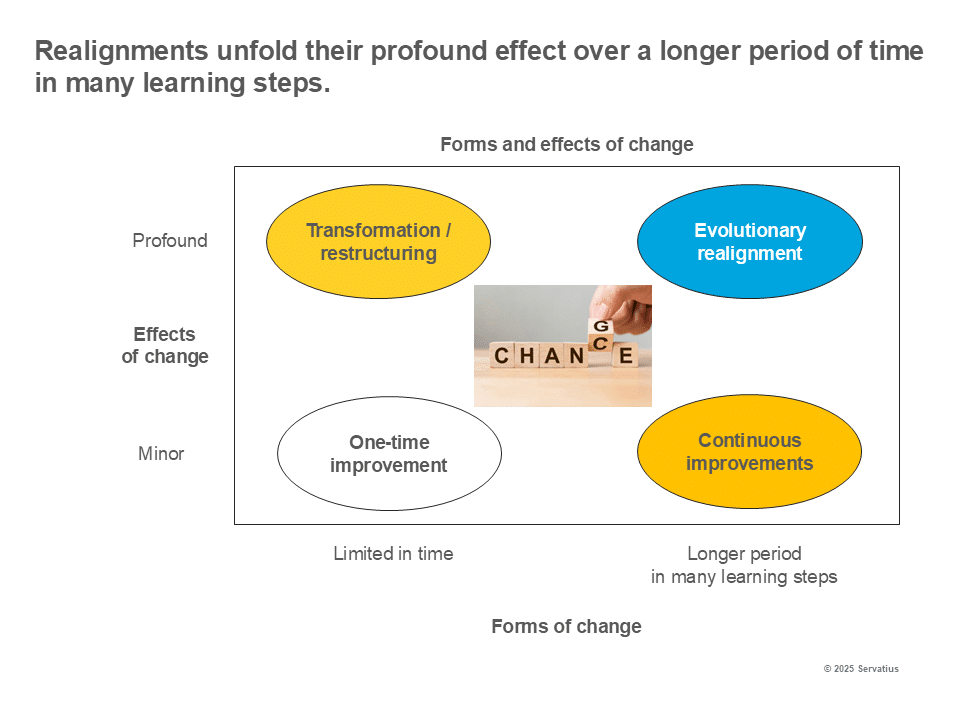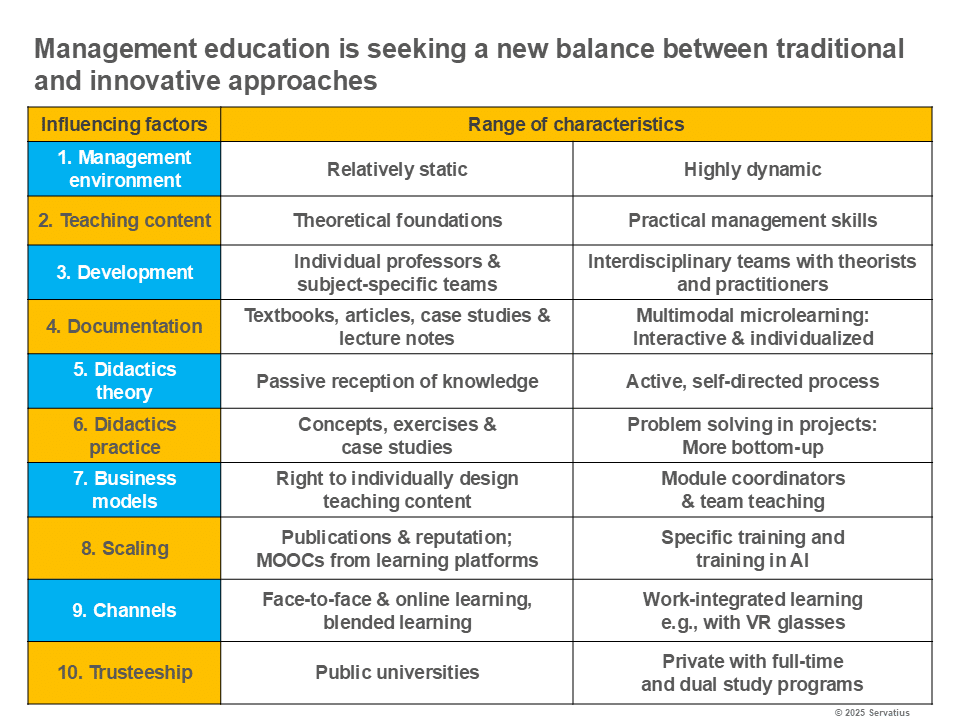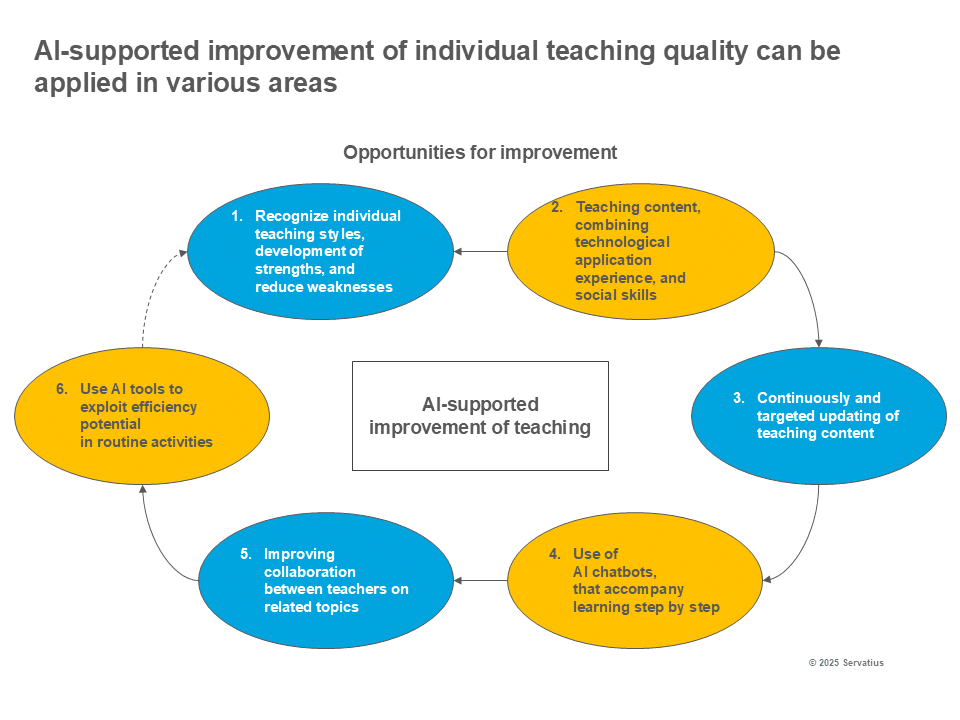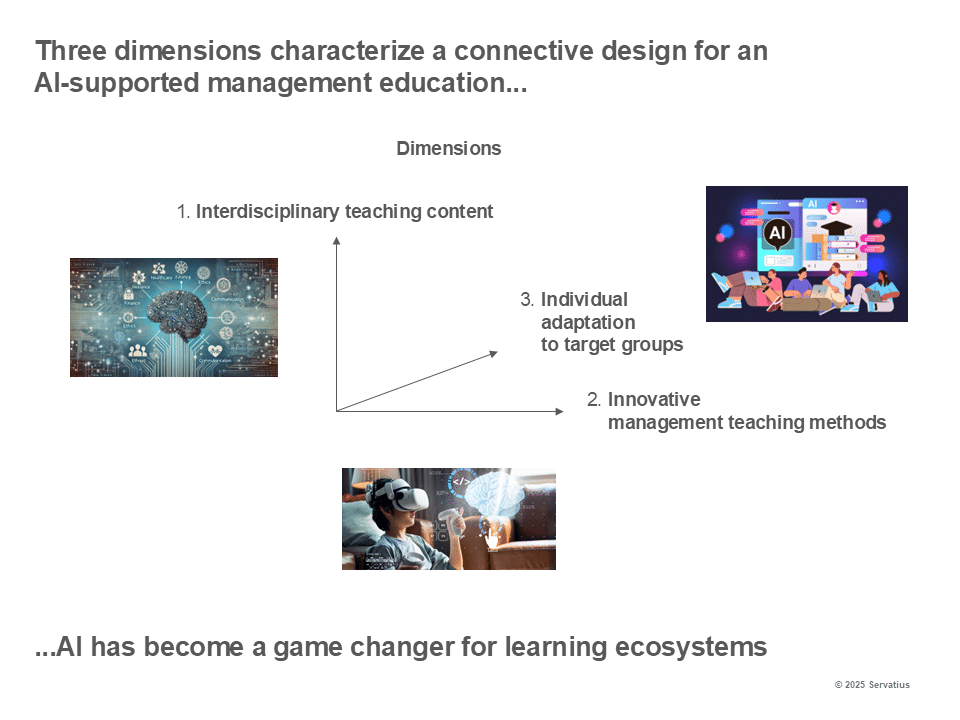One of the major challenges facing Europe is the AI-based strategic and organizational realignment of companies. An important prerequisite for success in this task is the improvement of management education within the framework of lifelong learning. In this context, university teaching and human resources development are seeking a new balance between traditional and innovative approaches. Using ten influencing factors, I outline the spectrum of existing characteristics. This presents opportunities for education providers to differentiate themselves in an increasingly competitive international market. Exciting questions arise as to who will continue to drive forward the long-standing disruption of management education and in what form.
In this blog post, I report on my experiences in university teaching and consulting on the topic of personnel development in the context of realignments.
Competitive advantages through AI qualifications
German companies owe their competitive advantages in the past century to a large extent to their globally recognized engineers. Qualifications in the development and application of artificial intelligence (AI) may be similarly important for the future. The conclusion would be that the part of the world that trains and educates its managers and employees best in AI will be the most successful. This opens up new opportunities for cooperation between companies and education providers. Management didactics for AI-based strategic and organizational realignments play an important role here.1 The first step is to clarify basic terms.
Realignment and transformation
The terms realignment and transformation have one thing in common and one difference. The commonality concerns the effects of change. These are profound in both realignments and transformations. In contrast, when the effects are minor, we speak of improvement. What differs, however, are the forms of change.
By the term realignment (or, better, „innoalignment“) of companies, we mean an innovative approach to coordinating important system elements, e.g., customers, business model, strategy, technologies, employees, organization, and culture. It is important to view these system elements in context. Realignments usually unfold their profound effects over a longer, not clearly defined period of time in many parallel learning steps. For example, digital change has been progressing for decades in ever new waves. This evolutionary character distinguishes realignments from time-limited transformations, in which change takes place in a big leap that often triggers defensive reactions.2 In this respect, transformation projects are similar to restructuring projects, which, however, focus on reactive crisis management.
The widely used term „transformation“ leaves unanswered the question of what happens afterwards, for example, if the environment continues to develop dynamically or if the hoped-for success of the transformation fails to materialize. Perhaps it is precisely this illusory nature of the term that is one reason for its unreflective use. It is therefore to be welcomed that renowned scientists such as sociologist Armin Nassehi are now taking a critical look at the topic of transformation.3
It seems that many who use the term transformation actually mean a process of realignment that is not limited in time, or at least hope that a new stable equilibrium will eventually be established after a successful transformation. Realistic management education, on the other hand, should be based on clearly defined conceptual foundations.
In the case of AI-based realignments, which are characterized by a high degree of uncertainty, a realistic understanding of change is an important prerequisite for success. It is also important to avoid mistakes.
Mistakes in AI initiatives
Various studies show that only a small proportion of AI initiatives are successful. There are many reasons for this.4 Often,expectations are exaggerated and there is a lack of well-prepared data. Other possible reasons include unclear guidelines and the uncoordinated use of too many AI tools. However, the main cause probably lies in the area of human resources, ranging from overburdened managers and a lack of training opportunities to employees‘ concerns about their jobs. Companies should therefore attach greater importance to management education when undertaking AI-based realignments. Management didactics is thus increasingly becoming a field of innovation.
Management didactics as a field of innovation
The term „management didactics“ refers to the theory and practice of teaching and learning in the field of management. Important drivers of innovation include fundamental changes in the world of work, which require new management concepts, and the use of AI-supported learning technologies.
Since the term, derived from ancient Greek, was coined by the educator and theologian Comenius in the early 17th century, didactics has evolved in many ways. Nevertheless, management didactics is a field of innovation whose importance has long been underestimated by many. This is evident, among other things, in the fact that university teachers are not required to have any training in didactics, but usually acquire the relevant skills themselves in the course of their work. Such learning by doing naturally leads to varying results.
Management education in search of a balance
In light of new challenges and learning technologies, management education and training are changing. There are a number of influencing factors, each of which can have a wide range of characteristics. One example is the documentation of teaching content, which is already less common in traditional textbooks and more prevalent in microlearning. In light of these influencing factors, management didactics is searching for a new balance between traditional and innovative approaches. This opens up a wide range of possibilities for lifelong learning, which is becoming increasingly important. Educational providers such as universities and publishers are faced with the task of reorienting themselves in this jungle and opening up interesting career paths for learners.
From my practical experience as a professor and consultant, ten influencing factors with a wide range of characteristics have emerged, which I will explain below.
The first two factors are the management environment and the teaching content.
Management environment and teaching content
Compared to today, the management environment used to be relatively static, and the need for lifelong learning was only beginning to emerge. This has changed fundamentally. The result of the highly dynamic environment is a shortening of the half-life of knowledge and skills.
One example is generative artificial intelligence. At the end of 2022, the introduction of the text robot ChatGPT by OpenAI triggered extreme hype.5 This has since been followed by a certain disillusionment, and experts are warning of an AI illusion.6 On the other hand, domain-specific AI, which specifically combines AI tools with applications, has gained in importance.7 These dynamic circumstances necessitate agile adaptation of teaching content. It is important to realistically assess trends and train learners to think critically.
In addition to the dynamics of teaching content, the balance between theory and practice plays an important role. The focus of traditional management studies is on theoretical foundations and concepts that are primarily taught by academically oriented instructors. In recent decades, the importance and influence of management consultants as bridge builders between theory and practice has increased. In a process of additional qualification, external consultants and in-house consultants improve their practical management skills on the job in the form of problem-oriented learning.8 Universities would be well advised to integrate this complexity-managing form of continuing education more strongly into their teaching.
This has important implications for the development and documentation of teaching content.
Development and documentation
In the past, the development of pioneering teaching content has been carried out primarily by individual professors who have worked on subject-specific management topics together with their doctoral students. This has resulted in a modular system of distinct elements of specialist knowledge for learners. This traditional concept needs to be supplemented. A new approach is the development of connecting skills by interdisciplinary teams consisting of both more theoretically and more practically oriented members.
Domain-specific AI provides an exciting example of this approach. The teaching content combines AI fundamentals with applications in individual management fields.9 Students learn from practitioners how to successfully implement a strategic and organizational realignment of companies.
In the past, teaching content has mainly been documented in the form of subject-specific textbooks, articles, case studies, and lecture notes. Some classic textbooks have been published in new editions over decades and have become very comprehensive. However, such „tomes“ are being written less and less and read even less. It is difficult for learners to distinguish which content in a work of several hundred pages is still relevant and which is not. However, the future documentation of teaching content is still more like a field of experimentation.
AI also plays an important role here. The goal is multimodal microlearning that is interactive and individualized. Content providers and new learning technologies such as learning experience platforms (LXP) are working together to design this microlearning.
This is accompanied by a change in the theory and practice of management didactics.10
Theory and practice of management didactics
For a long time, management didactics theory has focused on the passive reception of knowledge. The proportion of creative design, e.g., of new business models, was surprisingly low, even though subjects such as innovation management should focus on this skill. Here, too, a process of change is currently taking place. The focus is shifting toward a more active, self-directed process. Systemic-constructivist pedagogy provides a basis for this.11
The new generation of learners is growing up with AI tools, and intelligent input (prompting) is currently becoming a core competency. AI not only speeds up routine tasks, but also improves the search for creative solutions.12 Teachers and their organizations have the task of creating suitable learning environments for this.
There are major differences in the practice of management didactics between Germany and the USA, for example. While the focus in Germany is on learning concepts and applying them in exercises, management teaching in the USA has been dominated by case studies for decades. Management consultancies have provided important impetus for problem solving in projects. Collaborative learning places greater emphasis on bottom-up learning processes through internal company teams, in which trainers take on a coaching role.13
Innovative education providers are working to incorporate AI-supported project-based learning into education at an early stage. In this way, they are improving the career opportunities of learners and differentiating themselves from traditional universities.
This is changing the business models and scaling options of education providers.
Business models and scaling opportunities
The traditional „business model“ of leading universities is based on the principle of academic freedom, which is enshrined in Germany’s Basic Law. According to this principle, professors have the right to design their teaching content individually. At private business schools that operate at multiple locations, teaching content increasingly comes from module coordinators, who make the materials available to less experienced lecturers as inspiration. In team teaching, interdisciplinary teams with different backgrounds develop the teaching content. These changed business models can be geared toward both cost reduction and the realization of price premiums.
The late Harvard professor Clayton Christensen pointed out as early as 2010 the disruptive potential of business model innovations in management education, which is becoming increasingly apparent.14
The classic model of university scaling is based on the worldwide distribution of books and articles by management gurus, case studies, and the reputation of educational providers. This reputation enables the high prices of MBA programs and, in some cases, company-specific executive education. With the emergence of Massive Open Online Courses (MOOCs) in the 2010s, new opportunities have arisen for learning platforms to reach a large number of learners at relatively low cost.
It is foreseeable that in the coming years, most companies will need to provide their employees with continuing education tailored to their specific needs in the field of AI.15 Companies should not underestimate the social explosiveness of this issue if they have to lay off a large number of employees.
Other factors to consider are the channels and trusteeship of management education.
Channels and trusteeship
While traditional classroom learning offers little opportunity for interaction among large numbers of students, small groups are relatively cost-intensive. Online learning has a number of advantages, but often lacks the experiential quality of face-to-face learning through dialogue. Innovative education providers are therefore trying to combine the advantages of different channels with new formats. Blended learning, combining face-to-face and online events, is now widespread. One form of learning with a long tradition that could be experiencing a renaissance is work-integrated learning. Its roots lie in the dual vocational training system common in the skilled trades. A new interpretation is based on the use of digital technologies such as virtual reality (VR).
For several years now, companies have been using VR glasses for training and further education in the workplace. Business schools such as Insead are also experimenting with VR glasses in management education.16
Publicly funded universities are facing increasing competition in management education from private education providers, which charge higher prices but are also considered more individual and flexible. In addition to full-time courses, these often offer dual programs in which students spend part of their working time at a partner company. Dual study programs are very popular, but in my opinion, they have not yet reached their full potential. One area for improvement is the targeted coordination between learning at the business school and gaining relevant, practical experience in the company.
That is why we offer students individually tailored tasks for action-oriented learning with their practical partners. It becomes exciting when, for example, in a project learning situation on the topic of AI, the students‘ supervisors also contribute their experience.17
AI-supported disruption of management education
The outline of these factors with their different characteristics shows the potential for AI-supported disruption in management education.18 Artificial intelligence provides both new content and new tools for management education and training, with far-reaching implications for the business models of universities, companies, publishers, and providers of learning technologies.
The term business model disruption refers to a business model with a new value proposition for customers and barriers that are difficult for established competitors to overcome.19 Traditional universities, for example, are struggling to implement changed degree programs with AI as a basic and cross-disciplinary subject, as well as innovative content and learning technologies. The biggest barrier here is the pronounced reluctance of those responsible to change, which makes realignment difficult.
The topic of AI opens up opportunities for disruption in management education on a scale that cannot yet be fully predicted.20 One possible path is through AI-supported improvement of the individual quality of teaching. The following figure summarizes a few points on this topic.
The basic idea is that AI does not replace teachers, but rather supports them in improving the quality of their work. An important guiding principle is that the individual teaching style recognized by AI is retained. Based on specified criteria, AI then performs a strengths and weaknesses analysis using teaching samples. A first starting point is the development of strengths, e.g., the use of illustrative examples, and a reduction of weaknesses, e.g., too much frontal teaching.
One area with potential for optimization among many teachers is the goal of improving students‘ career opportunities in the AI age. An important contribution to this is to teach content that combines technological application experience with social skills.21 The actual future skills require a combination of the expertise of various specialists, which AI can support. This is particularly true for complex tasks involving interaction with customers and employees, e.g., in the context of challenging sales talks or conflicts within teams.
One task that has long overwhelmed many teachers is the continuous and targeted updating of their teaching content in the form of examples, questions, and short case studies. AI can also help to overcome this challenge and contribute to the design of new teaching content.
Another point is the use of AI chatbots to help learners explore the teaching content step by step. Google, for example, is pursuing this goal with its Gemini AI model and Guided Learning software, which aims to promote curiosity and critical thinking.22 The vision for the future is that every person will have a personal AI tutor who adapts to their individual learning needs.
In addition to individualizing learning, e.g., in complex projects, collaboration between teachers is becoming increasingly important. AI supports team teaching by helping to connect related topics, e.g., in interdisciplinary tasks.
AI tools that exploit efficiency potential in routine activities create more scope for these qualitative improvements. One example is support in the evaluation of exam performance, which is very time-consuming.
Overall, these and other points are leading to a next generation of management education in which teachers and learners work together with the support of AI. This can help to further develop the mindset in the respective stages of life. The question now is how to successfully implement AI-supported management education in practice.
Implementing concepts for AI-supported management education
Many universities and companies do not seem to be aware of how much management education and training is changing in the age of AI. Although there is no shortage of literature on the theoretical foundations of such a realignment,23 there is a lack of concepts for practical implementation.
One gets the impression that most players are still in individual experimental phases, which they are going through with limited commitment and caution. Large AI providers are acting differently, offering their customers free training programs in order to retain them. This approach has the advantage that it is at least based on clear objectives. However, it is necessary for universities and companies to implement their own concepts for AI-supported management education.
A hallmark of successful concepts is the connective design of the following three dimensions:
- The joint development and continuous updating of relevant interdisciplinary teaching content
- The implementation of innovative management teaching methods
- Individual adaptation to different target groups, from school pupils and students to professionals and executives.
Many players will not be able to develop and implement these concepts on their own. One foreseeable consequence of the disruption of management education is that private education providers offering outdated teaching content and methods, for example, will eventually disappear from the market.
The greatest pressure to act in the change of educational ecosystems is likely to be felt by companies that need to retrain a large number of their employees in AI-supported realignments. These companies will increasingly seek to collaborate with innovative partners. Therefore, the realization that every disruption presents an opportunity also applies here. Learning ecosystems around the world that understand AI as a game changer are taking advantage of this opportunity.
AI as a game changer for learning ecosystems
In our book on AI as a game changer, published in 2020, we identified shortcomings in German digital policy.24 These shortcomings still exist today in education policy, which should create conditions that promote innovation for the development and application of AI. Important inspiration comes from AI initiatives in other parts of the world. For example, the world’s first AI-only university has been established in the future city of Masdar near Abu Dhabi in the United Arab Emirates. In Saudi Arabia, 86 percent of bachelor’s degree programs now have an AI focus.25
In the global competition for the best AI support for management education, learning ecosystems in which various partners work together are likely to play a leading role. Possible partners include educational institutions, AI and LearnTech providers, as well as companies and public organizations as customers. New forms of cooperation are emerging in the US, China, the Gulf states, and Europe, but the outcome of the race is still open.
Studies on the use of AI assume that for many companies, the initial focus will be on increasing productivity. In addition, AI opens up a wide range of opportunities for business model innovation.26 Both approaches have a major impact on the future of work. In addition to job cuts in routine tasks, new job profiles are emerging, e.g., in the monitoring of AI results.27 Education providers must adapt to this. An important success factor is motivating learners to work with AI.
Combining the best of both worlds
In addition to my work as an honorary professor at the University of Stuttgart, I have long been an external lecturer in dual degree programs at private business schools. Universities and business schools have different strengths that actually complement each other perfectly. In the case of business schools, these include
- teachers with experience outside the education sector
- students who work in the field alongside their studies, and
- companies as practical partners that need to manage an AI-supported realignment.
The strengths of universities, on the other hand, are
- a broad spectrum of relevant subject areas such as business administration, computer science, and engineering
- professors and doctoral students with a focus on research, as well as
- funding from the public sector and third-party sources.
It would therefore seem logical for these two types of providers to cooperate on the subject of AI.
In practice, however, this has been the exception rather than the rule. One possible approach would be joint projects in which actors from both „camps“ work together with clearly defined goals. Currently, however, this is hindered by a pronounced distance between public and private business schools.
One promising way to combine the best of both worlds is to make the solution of complex problems in companies the subject of final theses. One example is the use of AI in sales and the cooperation with start-ups such as the Berlin-based company Parloa. In this context, teachers and students jointly train the application of problem-solving methods in projects, a skill that is becoming increasingly important in the age of AI. At the same time, this creates an application-oriented alternative to the strongly empirical management research that has become dominant in recent decades but is often of relatively little relevance to practitioners.
Conclusion
- Training and further education play an important role in the AI-supported strategic and organizational realignment of companies
- A number of influencing factors come together in the design of innovative management didactics
- The disruptive potential of AI can contribute to market consolidation in management education
- When implementing AI-supported management education, innovative learning ecosystems are changing the rules of competition.
Literature
[1] Servatius, H.G., Development and change in strategic management. In: Competivation Blog, September 19, 2025
[2] Servatius, H.G., Triple strategic realignment. In: Competivation Blog, June 7, 2024
[3] Nassehi, A., Critique of the grand gesture – Thinking differently about social transformation, 2nd edition, C.H.Beck 2024
[4] Merten, M., How can AI really add value? In: Handelsblatt, September 2, 2025, pp. 24-25
[5] Bomke, L., Holtermann, F., Scheuer, S., Between hype and disillusionment. In: Handelsblatt, August 29/30/31, 2025, pp. 48-53
[6] Dörner, A., Holtermann, F., Wiebe, F., The AI illusion. In: Handelsblatt, August 22/23/24, 2025, pp. 1, 4-7
[7] Servatius, H.G., Development of AI technologies. In: Competivation Blog, February 19, 2025
[8] Servatius, H.G., Learning to design solutions for complex management problems. In: Competivation Blog, July 15, 2025
[9] Servatius, H.G., Competitive advantages with knowledge-specific AI. In: Competivation Blog, February 11, 2025
[10] Floor, N., This is learning experience design – What it is, how it works, and why it matters, Pearson Education 2023
[11] Reich, K., Systemic-constructivist pedagogy – Introduction to the fundamentals of interactionist-constructivist pedagogy, Beltz 2010
[12] Servatius, H.G., AI as a tool for strategic management. In: Competivation Blog, May 1, 2025
[13] Hernandez, N., Collaborative learning – How to upskill from within and turn L&D into your competitive advantage, Kogan Page 2023
[14] Christensen, C.M., Horn, M.B., Johnson, C.W., Disrupting class – How disruptive innovation will change the way the world learns, McGraw-Hill 2010
[15] Servatius, H.G., Generative AI and Mass Customized Action Learning. In: Competivation Blog, August 28, 2023
[16] Stern, I., Epstein, A., Landau, D., Making VR a Reality in Business Classrooms. In: Harvard Business Review, November 8, 2021
[17] Jones, D., Modern PBL – Project-based learning in the digital age, Teacher Goals 2024
[18] Servatius, H.G., AI and the future of management education. In: Competivation Blog, April 9, 2025
[19] Servatius, H.G., How to recognize a disruptive business model. In: Competivation Blog, July 27, 2016
[20] Servatius, H.G., Disruption in management education. In: Competivation Blog, May 29, 2019
[21] von Schwanewede, S., Securing your own job value in the age of AI. In: Handelsblatt, September 16, 2025, pp. 22-23
[22] Scheuer, S., Chatbot Gemini to help with learning. In: Handelsblatt, September 8, 2025, p. 24
[23] de Witt, C., Gloerfeld, C., Wrede, S.E. (eds.), Artificial intelligence in education, Springer 2023
[24] Kaufmann, T., Servatius, H.G., The internet of things and artificial intelligence as game changers – Paths to Management 4.0 and a Digital Architecture, SpringerVieweg 2020, p. 203 ff.
[25] Witsch, K., Bomke, L., Rogg, I., The new tech superpowers. In: Handelsblatt, October 2/3/4/5, 2025, pp. 42-48
[26] Hübner, G., Artificial intelligence as a growth driver. In: Handelsblatt, November 28, 2025, p. 28
[27] Burkhardt, K., Efficiency and new tasks. In: Handelsblatt, September 25, 2025, p. 30





